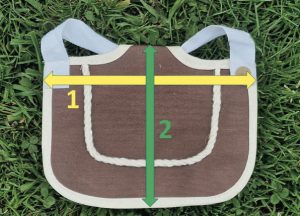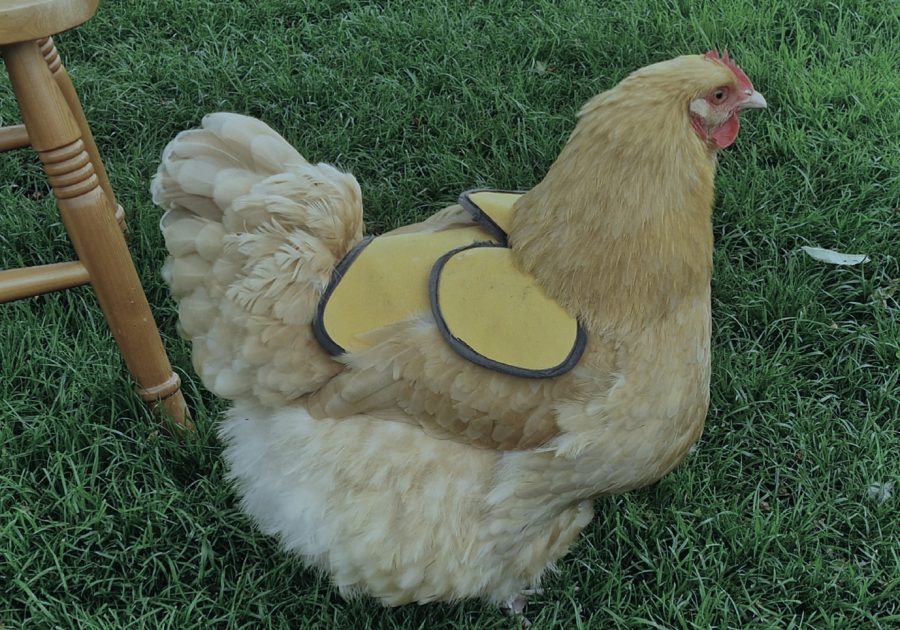When Fiona & Hugh Osborne were first introduced to the concept of chicken saddles it conjured up images of chickens racing across a field with tiny little jockeys bobbing up and down on their backs. But chicken saddles are an incredibly important tool to chicken breeders or anyone who has a flock with a cock bird or cockerel.
WHAT IS THE PURPOSE OF A SADDLE?
Essentially, it’s simply a piece of heavy canvas that sits on a hens’ back passing under the wings. There’s a material tape at the top of the saddle that fits over the hen’s wings securing it in place.
Cock birds and cockerels will tread the hens in their flock to mate. They do this by standing on the back of the hens placing their feet sometimes as high at the top of the hens’ wing. Their aim is to bring their cloaca in contact with the hen’s cloaca.
Whether you breed chickens and have a purpose for any fertilised eggs that result, or simply want a male bird in your flock, there is a hormonal imperative for the cockerel to tread the hens. The problem comes when treading becomes excessive. Each time a male chicken climbs on the back of a hen, he will be rubbing away at the feathers on a hens’ back. The more that this happens, the more damage there will be to the feathers. In extreme cases the hen’s feathers will be worn away completely and they’ll be left with a bald spot on their back.
A chicken saddle forms a protective pad between the cock bird’s feet and the hens back, reducing the risk of feather wear. It can make the act of treading more comfortable for the hens too as the cock birds claws no longer have direct contact with their backs.
THE CONSEQUENCES OF FEATHER WEAR
Just imagine what a bald spot would mean to a chicken. Imagine a hot summer day with blazing sunshine. Any human that is going to be in the sunshine for many hours would most likely use some kind of sun protection to prevent sunburn whether that’s sun cream, a hat, a shirt or sun block. A chicken’s skin has the same risk of sunburn as a human’s so a bald spot can have grave consequences.
The chicken saddle isn’t designed to provide that sun protection. What’s it’s designed to do is to prevent or at least significantly reduce the risk of feather wear happening in the first place. It’s essentially a physical barrier between the cock bird’s feet and the hen’s back.
IS A CHICKEN SADDLE 100% GUARANTEED TO PREVENT FEATHER WEAR?
Unfortunately, not. It’s possible that the cock bird will manage to inadvertently get his feet underneath a saddle. As a result, feather wear won’tbe prevented but it will be significantly reduced.
ARE THERE OTHER WAYS OF PREVENTING FEATHER WEAR?
The risks of feather wear can be minimised in the flock overall by:
- Increasing the number of hens per cock bird
- Increasing the space available to the flock.
Although this will reduce the risk of feather wear in the flock overall, cock birds will still select a favourite hen. This year in our flock, it was Taffy. Our young cockerel actively sought her out and during flockdown (the Avian Influenza Housing Order imposed on 6th November 2022), when we had 11 hens and one cockerel in large 21m x 3m enclosure, Taffy had no way to remove herself from his romantic advances. Fitting her with a saddle was essential. In reality, due to the reduced space this normally free ranging group had, every Orpington hen in the group needed to be fitted with a saddle by the end of flockdown.
 SIZING A CHICKEN SADDLE
SIZING A CHICKEN SADDLE
A well fitted saddle is incredibly important for a hen both for function and comfort.
There are two measurements that matter. The first is the width measured from under a wing to under the other wing. As the saddle is secured via a tape that passes over each wing, too loose and the saddle will slip off but too tight and it will be uncomfortable.
Most saddles that are sold come with a tape that is too long, but this is better than too short; a tape can be shortened, but can’t be made longer! If you find that the saddle keeps slipping off, a small dart can be sewn in the tape to shorten it. This might need to be repeated until the saddle no longer falls off.
The second measurement is arguably more important. The length from the shoulder blades to the uropygial gland at the base of the hen’s tail should dictate the size of saddle for the hen.
The uropygial gland is situated at the base of a chicken’s tail. We have answered many questions over the years from social media followers who are new chicken keepers worried that their chickens have potentially dangerous growths when they first find the uropygial gland. It’s an important part of the chicken’s anatomy as it produces the protective oil that the chickens use to preen their feathers, keeping them in tip top condition.
As a result, a chicken saddle must be long enough to cover the back of the hen, but not so long than it prevents the hen from accessing the uropygial gland for preening. Each hen is different so careful measuring before purchase is important for each individual. We have a stock of four different sizes as, for example, both our Cream Legbars and our Orpingtons wear two different sizes within the breed dependent on the size of the hens.
FORMATS OF CHICKEN SADDLES
Chicken saddles come in many different formats:
- A basic canvas saddle
- A fleece lined saddle
- A “butterfly” saddle
Which is best? The choice is yours and it differs based on circumstances within your flock.
The basic saddle: This is the most cost-effective solution and does the job in reducing feather wear very well.
The fleece lined saddle: This is our preferred saddle. It adds an extra layer of protection as a landing spot for the cock birds’ feet when he treads. We feel it’s also softer against the feathers than the basic saddle. It’s possible it makes no difference at all, but we prefer it.
The butterfly saddle: This format adds some extra protection across the top of the hens’ wings. This is a format that is preferable if you have a cock bird who treads very high on the hens’ backs. In this case, the feathers at the shoulder joint can be worn away and a butterfly saddle will reduce this risk.
To receive regular copies of The Country Smallholder magazine featuring more articles like this, subscribe here.
For FREE updates from the world of smallholding, sign up for The Country Smallholder newsletter here.







